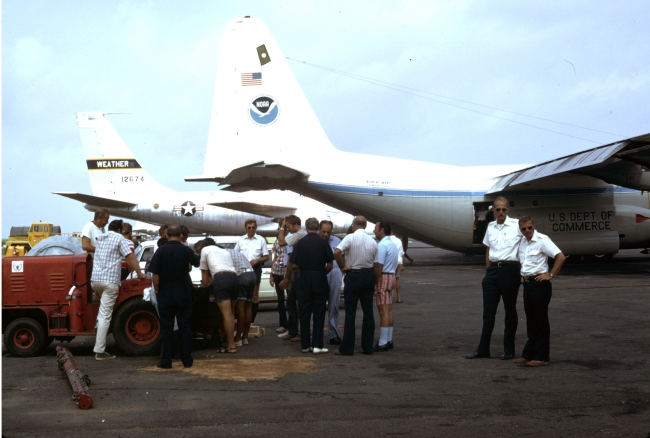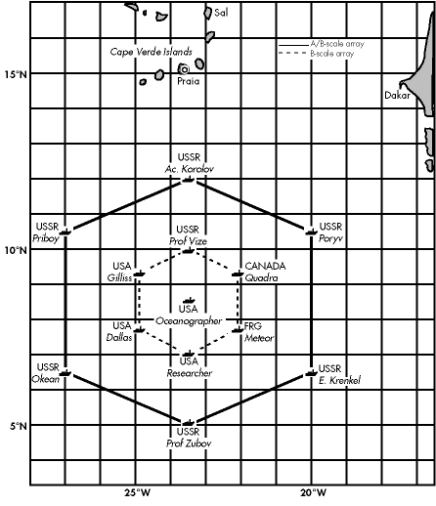On June 15, 1974, one of the largest meteorological experiments ever carried out began. The GARP* Atlantic Tropical Experiment (GATE) stretched across the tropical Atlantic, from western Africa to Barbados. This international effort used resources from 20 different countries, including 40 ocean-going vessels, a dozen research aircraft, buoys, balloons, and weather stations on land and at sea. Over 1000 engineers, technicians, pilots, computer programmers, and tropical meteorologists joined in the effort to examine convection and air-sea interaction in this critical breeding ground for Atlantic hurricanes.
The main focus was on an array of 13 research vessels laid out in two concentric hexagons southwest of Dakar, Senegal. They monitored changes in the atmosphere and ocean as weather disturbances (known as African easterly waves) left the continent and moved over the Main Development Region of the tropical Atlantic waters. The research aircraft would daily fly various patterns over and around this array to gather information on the lower atmosphere, while newly inaugurated geostationary satellites kept watch from above. Over the next 84 days (broken down into three phases) millions of observations were recorded for later analysis.
 NOAA C-130 with other research aircraft at Dakar airport during GATE 1974 (credit Paul Willis)
NOAA C-130 with other research aircraft at Dakar airport during GATE 1974 (credit Paul Willis)
A large number of studies were produced using GATE data that helped define the role of tropical cloud clusters in driving atmospheric circulation. Some papers by HRD personnel produced from GATE information are:
- “Low Altitude Internal Waves North of the GATE Array”, , Monthly Weather Review, Volume 103, Issue 2 (February 1975) pp. 167-169
- “Radiative characteristics of Saharan dust at solar wavelengths”, Toby N. Carlson and R.S. Caverly, Journal of Geophysical Research, Volume 82, (1977), pp.3141-3152.
- “A Radar Study of Convective Cells in Mesoscale Systems in GATE. Part I: Vertical Profile Statistics and Comparison with Hurricanes”, , , Journal of the Atmospheric Sciences, Volume 43, Issue 2 (January 1986) pp. 182-198
- “Further Analysis of the Composite Wind and Thermodynamic Structure of the 12 September GATE Squall Line”, , Robert A. Houze Jr., Monthly Weather Review, Volume 113, Issue 8 (August 1985) pp. 1241-1260
* GARP was the Global Atmospheric Research Programme, a WMO sponsored multi-decadal effort to better understand how the weather functioned on a world-side scale.


